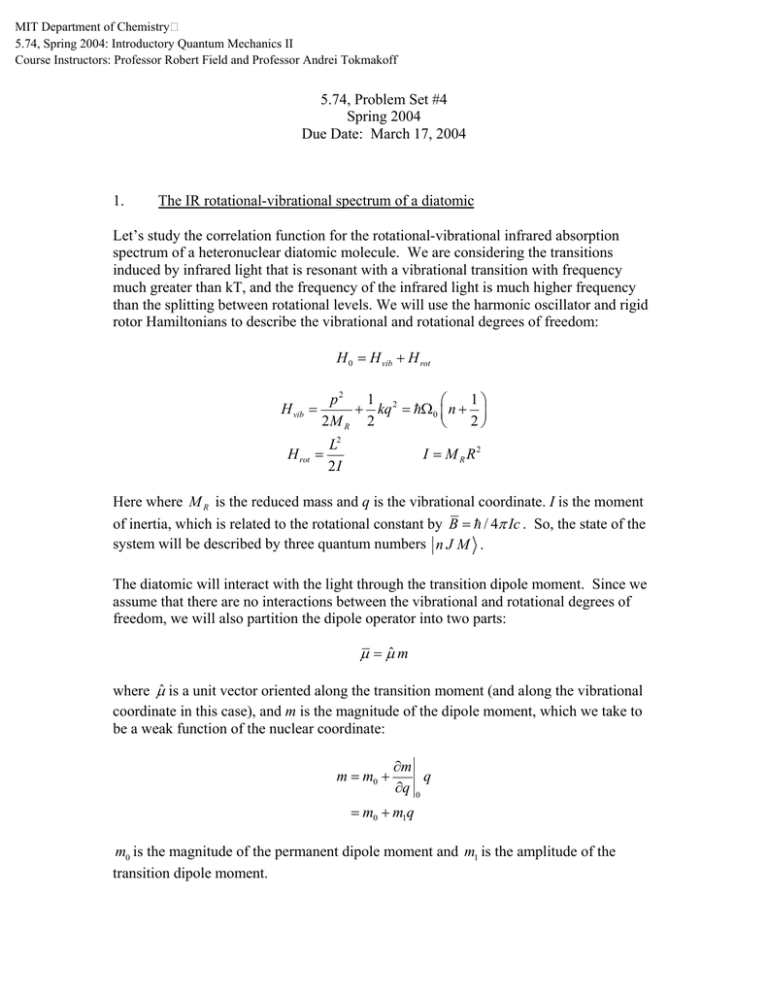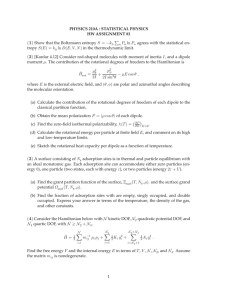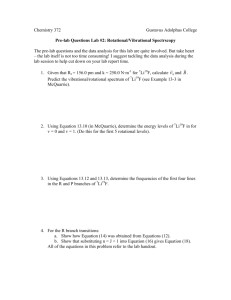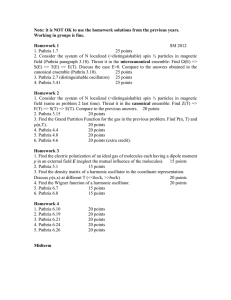MIT Department of Chemistry� 5.74, Spring 2004: Introductory Quantum Mechanics II
advertisement

MIT Department of Chemistry� 5.74, Spring 2004: Introductory Quantum Mechanics II Course Instructors: Professor Robert Field and Professor Andrei Tokmakoff 5.74, Problem Set #4 Spring 2004 Due Date: March 17, 2004 1. The IR rotational-vibrational spectrum of a diatomic Let’s study the correlation function for the rotational-vibrational infrared absorption spectrum of a heteronuclear diatomic molecule. We are considering the transitions induced by infrared light that is resonant with a vibrational transition with frequency much greater than kT, and the frequency of the infrared light is much higher frequency than the splitting between rotational levels. We will use the harmonic oscillator and rigid rotor Hamiltonians to describe the vibrational and rotational degrees of freedom: H 0 = H vib + H rot H vib = p2 1 1 + kq 2 = =Ω0 n + 2M R 2 2 H rot = L2 2I I = M R R2 Here where M R is the reduced mass and q is the vibrational coordinate. I is the moment of inertia, which is related to the rotational constant by B = = / 4π Ic . So, the state of the system will be described by three quantum numbers n J M . The diatomic will interact with the light through the transition dipole moment. Since we assume that there are no interactions between the vibrational and rotational degrees of freedom, we will also partition the dipole operator into two parts: µ = µˆ m where µ̂ is a unit vector oriented along the transition moment (and along the vibrational coordinate in this case), and m is the magnitude of the dipole moment, which we take to be a weak function of the nuclear coordinate: m = m0 + ∂m q ∂q 0 = m0 + m1q m0 is the magnitude of the permanent dipole moment and m1 is the amplitude of the transition dipole moment. For the following, the system will interact with an electric field oriented along the εˆ = ẑ axis of the laboratory. Remember that in describing the probability of occupying an initial state, we need to consider both probability of occupying the initial state at temperature T and the probability of having a particular orientation in the laboratory frame. The initial state of the system will always be isotropically distributed, i.e. equal probability of finding a dipole oriented in any direction. a) Evaluate the dipole matrix element k εˆ ⋅ µ A for the interactions between an initial state A = n J M and a final state k = n′ J ′ M ′ using the separation of orientational and vibrational variables. Calculate this only to the leading order expansion coefficient for m. b) Evaluate the correlation function µ ( t ) µ ( 0 ) for a gas phase ensemble of molecules at pressures low enough to neglect interactions between molecules. c) Plot the correlation function for temperatures from B / kT >> 1 to B / kT << 1 but neglect temperatures high enough that you need to consider n=2. Be sure to point out the important features of the time-dependent behavior. You will probably want to plot the rotational, vibrational and combined contributions separately. For the purpose of plotting results, you can use Ω0 = 2000 cm-1 and B = 5 cm-1. d) Calculate the analytical form of the spectrum corresponding to the correlation functions in (b) and plot the lineshapes. Point out how the frequency resolved features in the spectrum were manifested in the time-dependent behavior in (b). e) Now lets investigate the role of collisions between molecules in the spectrum, for instance as we raise the pressure. Let’s assume that the rotational phase of molecules is randomized by collision with another molecule. To simulate this we will say that i ⋅φ t the time evolution of the dipole operator contains an extra term µ (t ) ⇒ µ (t )e ( ) with φ(0)=0. We will treat the time evolving phase as random variable that evolves through small shifts, and the probability distribution of a member of the ensemble having a certain phase is given by the solution to a diffusion equation in φ: Pφ ( t ) = φ 2 (t ) 1 exp − 2πζ t 2ζ t This distribution function would work for small changes in rotational phase with each collision. Here ζ is the “phase diffusion constant” which we will take to be equal to the mean frequency of collisions from the kinetic theory of gases: ζ = 2π d 2 p c kT (⟨c⟩ is the mean speed of molecules (8kT/πm)1/2, d is the effective molecular diameter). Derive an expression for the new correlation function where the ensemble average includes the phase variation due to collisions during the time-period t in the correlation function. Plot and discuss how this function and the rotational spectrum change as the pressure of the gas is increased from ζ >> B to ζ<<B. 2. Linear Response Theory Describe the time-dependent response of an operator A when it is driven by an external field f(t) applied to an equilibrium system at time t0=0. The Hamiltonian for our system is H ( t ) = H 0 − f ( t ) A = H 0 +V ( t ) , so we can treat this problem in the interaction picture. We want to describe the non-equilibrium response of an ensemble A ( t ) which we will get by ensemble averaging the expectation value of A(t). a) Show that the time-development of the operator A is given by A ( t ) = AI ( t ) + i t dt ′ f ( t ′ ) AI ( t ) , AI ( t ′ ) , = ∫0 when only terms linear in the external field (first-order terms) are retained. b) Remembering that the external field is applied equally to all members of the ensemble, show that the ensemble response is given by ∞ A (t ) = A + ∫ d τ f (t − τ) R ( τ) , 0 where the linear response function R ( τ ) is related to the correlation function by R ( τ) = 2 Im C AA ( τ ) . = 3. Displaced Harmonic Oscillator Model Work through the correlation function description of the electronic absorption spectrum for a transition coupled to nuclear motion, using the displaced harmonic oscillator model discussed in class. The Hamiltonian for the ground and excited electronic states is given by: H 0 = g H gTOT g + e H eTOT e p2 1 2 + 2 mω02 ( Q − d ) + Ee 2m p2 1 = H g + Eg = + 2 mω02 Q 2 + Eg 2m H eTOT = H e + Ee = H gTOT a) Use the Born-Oppenheimer and Condon approximations to show that at T = 0 K: µ I ( t ) µ I ( 0 ) = µ eg 2 e−iω t F ( t ) , with F ( t ) = 0 eiH t / = e−iH t / = 0 . eg g e b) Show that the latter expression can be re-written as F ( t ) = 0 e c) Using p(t ) = U g p(0)Ug show that p ( t ) = i † ˆ ˆ ˆ ˆ d) Using the identity e A+ B = e Ae B e F (t ) = e where d = d ~ −d2 ~ ˆ ˆ − 12 A,B m=ω0 † iω0t a e − a e − iω0t 2 ( write F(t) as 0 exp − d a e− iω0t exp d a† 0 ~ ~ mω0 . 2= e) Use the relationship ˆ ˆ e  e B = e B e  e [ ] − B̂ , to get the final form of the dipole correlation function µ I ( t ) µ I ( 0 ) = µ eg exp −iωeg t + d ~ 2 2 (e −idp ( t ) / = − iω0t ) −1 . ) e idp ( 0 ) / = 0 . 4. Displaced Harmonic Oscillator Model at Finite Temperature (a) Show that the energy gap correlation function for coupling to a single harmonic mode is written δωeg ( t) δωeg ( 0 ) = ω02 D ( n +1) e−iω0t + n e+ iω0t Here n is the thermally averaged occupation of the harmonic oscillator. (b) Find the real and imaginary parts of the lineshape function g ( t ) = g ′ ( t ) + ig ′′ ( t ) . (c) Calculate the lineshape using the short time expansion. What is the linewidth and how does it scale with temperature for kT =ω0 ?






